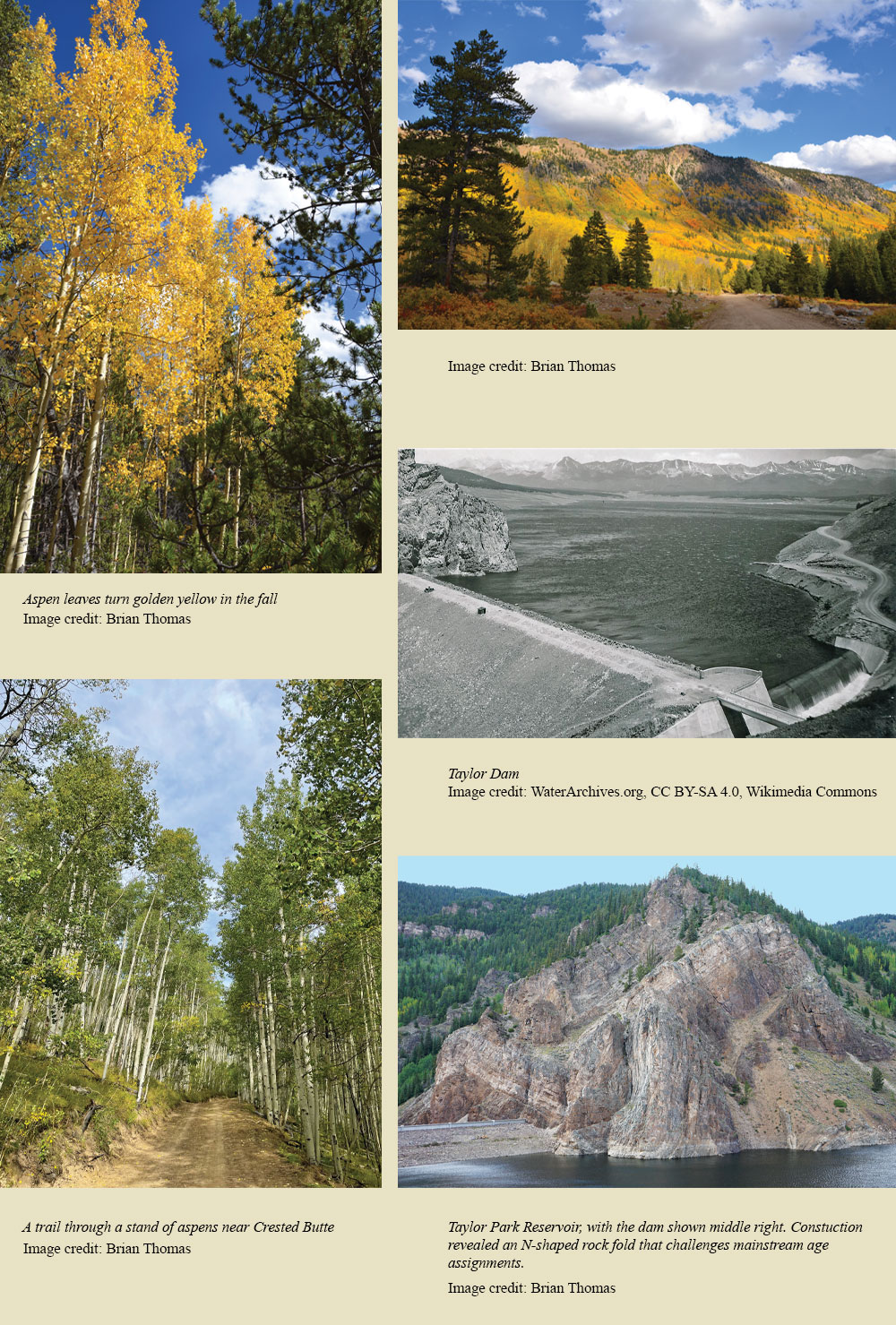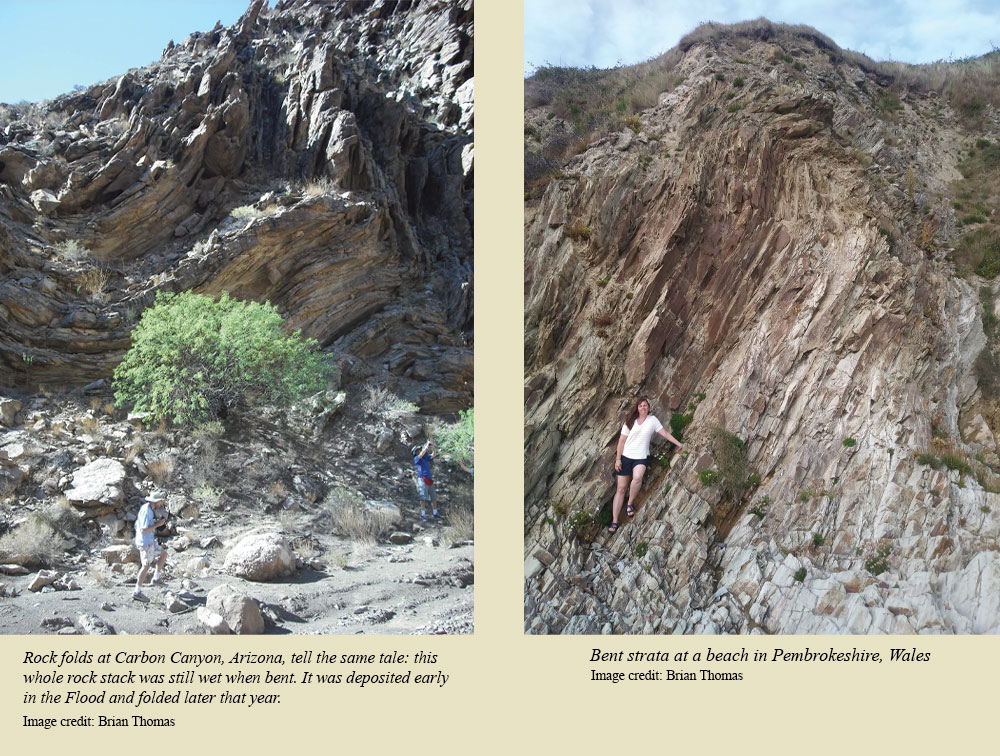Gunnison National Forest’s 1.67-millionplus acres showcase stunning views of the Colorado Rocky Mountains. The Continental Divide forms its eastern border, and other parks nestle against its many sides. Among myriad wonders are particular trees and rock exposures that point thoughtful visitors to two key biblical events.
Quaking Aspens
Many consider the quaking aspen of North America, Populus tremuloides, their favorite tree for its pillar-like, off-white trunks, leaves that flutter or “quake” in the slightest breeze, and fantastically golden fall foliage. Two clearly seen engineered aspects of aspen biology point to creation.
Every decision a human inventor makes during design and construction balances competing needs and demands. Consider a pen. Someone decided its size—suitable for human hands—and its long-lasting but inexpensive material. The inventor(s) selected the right chemical mixture for an ink that would flow at just the right rate, stay visible on paper, and conserve cost.
All this handiwork reveals that engineering decisions were made to achieve the final result. The same applies to what we see in the world, which includes aspens. The Creator “established the world by His wisdom” during the first key biblical event—creation (Jeremiah 10:12).
Consider the remarkable bark of the aspen tree. Most trees have thick, protective bark. Not the aspen. As is the case with all strategies and structures, disadvantages balance advantages. On one hand, the aspen’s growth strategy uses bark thin enough for elk and insects to eat, possibly weakening the tree. On the other hand, cells in its thin bark perform photosynthesis.1 Even after its leaves have dropped for the winter, an aspen receives an off-season metabolic boost that counters the need to repair bark damaged by hungry animals.
Not only does photosynthetic bark point to creation, but engineered propagation strategies also point to it. Aspens are dioecious, making either male or female flowers. Once pollinated, their flowers grow in small clusters called catkins to produce genetically different offspring while holding the aspen’s identity as a “tree that yields fruit, whose seed is in itself according to its kind” (Genesis 1:12). Aspen seeds are tiny and tufted so wind can carry them great distances.
This strategy for sexual reproduction ensures that future generations can receive genetic benefits, especially including trait adjustments from recombined alleles.2 Biologists attribute the success of aspens in pioneering huge swaths of landscape from Canada to Mexico to their expansive genetic toolbox. One recent study found 1,000 genome adjustments just in relation to temperature and water fluctuations.3 Aspens give us a golden example of engineered adaptation.
Aspens also propagate through shoots that rise from extended lateral roots. Eventually, thousands of “trees,” each called a ramet, can share the same root system. Together, they make up a clonal patch called a genet. This strategy enables an entire genet to share resources like water and to efficiently pioneer new places or rebound from natural disasters.4 And the genet keeps growing even if animals eat a few shoots.
How do aspens know when it’s a good time for a lateral root to send up a shoot? When light detectors in the bark sense full sun, e.g., at the edge of a grove, they signal appropriate root cells to grow a shoot poised perfectly to pioneer sunlit spaces. Someone must have programmed that information into their cells. Aspens use that programming to continuously track their environment for light intensity, process that input, and deploy an output that suits the detected situation. Who deserves the credit for this growth strategy? Not the creature but its Creator, “His Son…through whom also He made the worlds” (Hebrews 1:2).

Taylor Park Reservoir
While these two aspects of engineered biology—photosynthetic bark and growth strategies—reflect creation, nearby rocks point to Noah’s Flood. Workers in 1937 blasted rock to build a dam and form Taylor Park Reservoir in eastern Gunnison National Forest. The paved road to the park rises up the Taylor River valley and over the dam. Travelers can now see what was long hidden: bent strata. Some great forces turned these once-flat rocks into a colossal “N” shape. These sedimentary layers are thick and extensive. How and when did they form and bend?
Conventional thought attributes this to long eons of slow folding. The now-bent layers have age assignments of 400-and-more million years,5 while mountain-building (thus rock-bending) forces supposedly occurred on the order of 60 million years ago. That would have given the sediments plenty of time to harden, or lithify. Once lithified, they would have cracked and splintered under such pressures instead of bending. We see no such shattering of rock here or at other locations that expose bent strata.
These sediments must have behaved plastically and been moldable, not yet lithified, in order to fold as they did. If mere months elapsed between when the deposits formed and when mountain-building activity bent them, then these bends delete hundreds of millions of supposed years in their development.
This is what we should expect from Noah’s global Flood. The ICR Flood model posits that multiple extensive sedimentary layers were deposited during the Flood year.6 Catastrophic plate tectonics made an entirely new seafloor and rapidly moved the continents around. Colliding plates and thickened crust forced those sediments up to form the Rocky Mountains along with most other mountains.
Since Scripture teaches the Flood was worldwide and recent, rock folds from early Flood layers (conventionally called Paleozoic) should occur all over. Images here show just that. Such extraordinary power spread so widely matches a global flood—the second key biblical event that Gunnison National Forest points to.
Like in many other parks covered in this “park series” of articles, the engineered biology and catastrophic geology in Gunnison National Forest testify to the truth of Genesis history. We really do live on a created, then flooded, earth.


References
- Berveiller, D., D. Kierzkowski, and C. Damesin. 2007. Interspecific Variability of Stem Photosynthesis among Tree Species. Tree Physiology. 27 (1): 53–61.
- Thomas, B. 2023. Trait Variation: Engineered Alleles, Yes! Random Mutations, No! Acts & Facts. 52 (7): 12–14.
- Goessen, R. et al. 2022. Coping with Environmental Constraints: Geographically Divergent Adaptive Evolution and Germination Plasticity in the Transcontinental Populus Tremuloides. Plants, People, Planet. 4 (6): 638–654.
- Peltzer, D. A. 2002. Does Clonal Integration Improve Competitive Ability? A Test Using Aspen (Populus tremuloides [Salicaceae]) Invasion into a Prairie. American Journal of Botany. 89 (3): 494–499.
- Streufert, R. K. et al. 1999. Geologic Map of Gunnison County, Colorado. Colorado Geological Survey. Resource series RS-37. Posted on ngmdb.usgs.gov.
- Clarey, T. 2020. Carved in Stone: Geological Evidence of the Worldwide Flood. Institute for Creation Research, Dallas, TX.
* Dr. Thomas is a research scientist at the Institute for Creation Research and earned his Ph.D. in paleobiochemistry from the University of Liverpool.



















